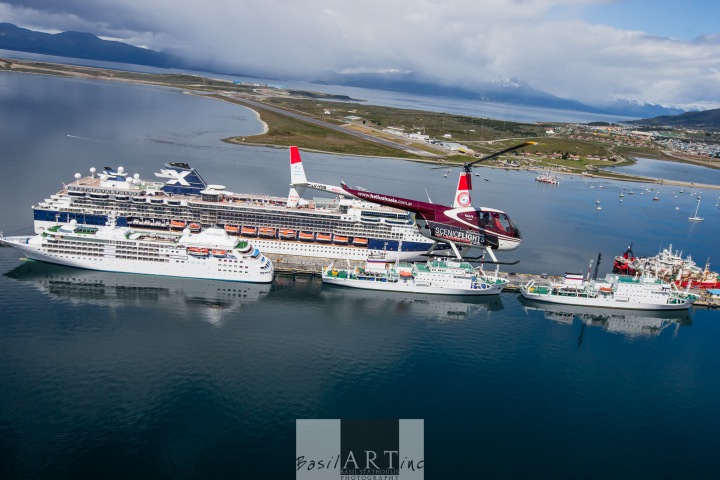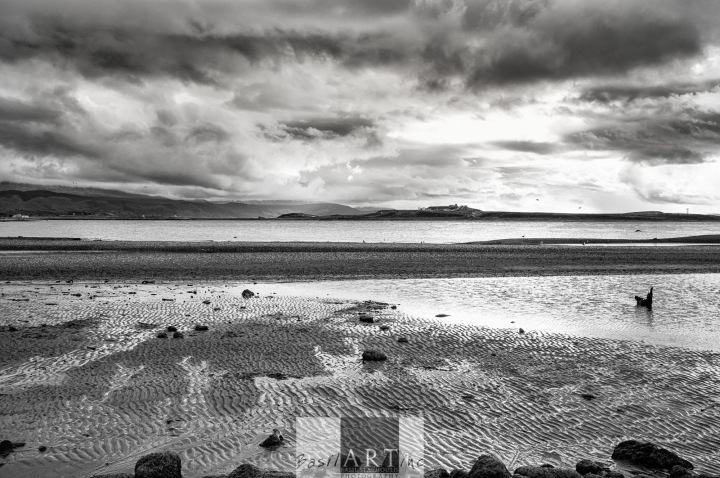Westpoint Island

After an eternity at sea (less than two days for me) we sighted land in the early morning: The West Falklands. Excited

as little boys going camping we packed and check our gear and boarded the Zodiacs in a little bay of Westpoint Island. Between us and land, in the 500 meters or so, was a small yacht that turned out to belong to a couple that had sailed around the world and were now helping the elderly couple who had the cattle and sheep farm on Westpoint. Small yachts make me very nervous, even though one of my boyhood heroes was “The Boy Who Sailed Around the World Alone”.
Brightly coloured exposed outbuildings and a wind turbine contrasted the white stone cottage tucked away behind the bent trees standing guard and protecting it from the harsh elements.
Westpoint was dry and stark. Away from the farm there were no trees, just grass. We walked about 1.5 km up and down over the spine of the island to a communal roost of Black-Browed Albatross and Rock-Jumper Penguins. There were two colonies. We arrived at the larger one and then I split away to the smaller one, where I was alone with Johan Slazus.

It was mesmerizing watching them. They were intermingled, the albatross and rock-jumpers both with young. Great

wings were flying in to regurgitate feed and landing clumsily. While the penguins did the same, only not by flying but by jumping from boulder to boulder, but with a quick grace that was lost as soon as they started waddling again. Every so often a scuffle would break out between the two species.

I found the photography difficult. It was so difficult to isolate an animal and still tell a story. Then the group was so large and mixed I just could not find a pattern or texture. But what the pictures do not show is the hectic noise of squawking and babbling nor does it reveal the strong ammonia stench of the guano.
The IATO (International Antarctic Tour Operators) guidelines say to maintain a distance of 5 meters from the fauna, but as you place yourself 5 meters away from some birds in thick tussock grass and settle in to take pictures, you have penguins ambushing you from behind.
There was a Striated Caracara (a bird of prey) hovering and then landing around the smaller colony looking for unguarded chicks or eggs. I spent an hour waiting and watching as he jumped around and flew from one side of the colony to the next, landing in the thick tussock grass then emerging like a camouflaged marine from the shadows only to be rebuffed by the penguins, often in a small group standing like infantry and soaring with their beaks.

After a few hours we made our way back to the farmhouse where a large table lay inside groaning with biscuits, cakes and scones. I had a cup of tea as only the English can make, and snacked on a delicious shortbread biscuit. The hosts were so excited to have guests.
Outside on the hill stood a lone Landrover and a rock hanging from a tripod: the weather predictor:
- If the rock is wet, it’s raining.
- If the rock is swinging, the wind is blowing.
- If the rock casts a shadow, the sun is shining.
- If the rock does not cast a shadow and is not wet, the sky is cloudy.
- If the rock is not visible, it is foggy.
- If the rock is white, it is snowing.
- If the rock is coated with ice, there is a frost.
- If the ice is thick, it’s a heavy frost.
- If the rock is bouncing, there is an earthquake.
- If the rock is under water, there is a flood.
- If the rock is warm, it is sunny.
- If the rock is missing, there was a tornado.
- If the rock is wet and swinging violently, there is a hurricane.
- If the rock has white splats on it, watch out for birds.
This simple and obvious weather predictor seemed appropriate for the Falklands.



Carcass Island
Just a few kilometers from Westpoint to the north lay a beautiful azure bay with white coral powder beaches. The name derives not from whale carcasses but from the survey undertaken of the island in 1766 by HMS Carcass.
The short intense history of the area from the Falklands to the Sub-Antarctic Islands to the Antarctic itself is one of the impressive aspects of travelling to such southerly latitudes. As you get further south it is likely that the only exploration of these areas occurred in the last century or two. Unlike the rest of the ocean, that had been navigated by the Phoenicians and Greeks and Chinese thousands of years ago. It leaves the sights you see relatively fresh in the collective subconscious of our race.

We landed on a beautiful white powder beach lying in a long crescent with small waves lapping the beach from the sea. The beach was filled with Magellanic Penguins and a few other birds, including black oystercatchers. The tragedy is that the island lies on a shipping lane and the high tide mark is littered with debris of our modern civilisation.
We had great fun taking pictures of penguins running along the water’s edge, diving into the small

waves and emerging from the water It was all low level shooting so we were lying in the sand and body and cameras were covered in the fine white salty powder.
After the shoot we boarded the Zodiacs and made our way to the end of the bay to a homestead which is owned by Mr. McGill who is a third generation islander. They have a bed and breakfast now to augment the farm, and business is booming. Funny, you take an Englishman anywhere and he opens a B&B. Take a Greek anywhere and you get a corner shop! We had another table laid high with all sorts of pastries and cakes made by the local Argentinian specialist pastry chef and chatted a while before fighting our way through the resident flock of caracaras who ambush guests still holding a piece of cake outside. They resemble crows in behavior but do have strong eagle like flight.
This was the second last day of 2013, and over night we were cruising in relatively still waters to the eastern shores of the Falklands, to spend the day at Stanley, the capital.


















